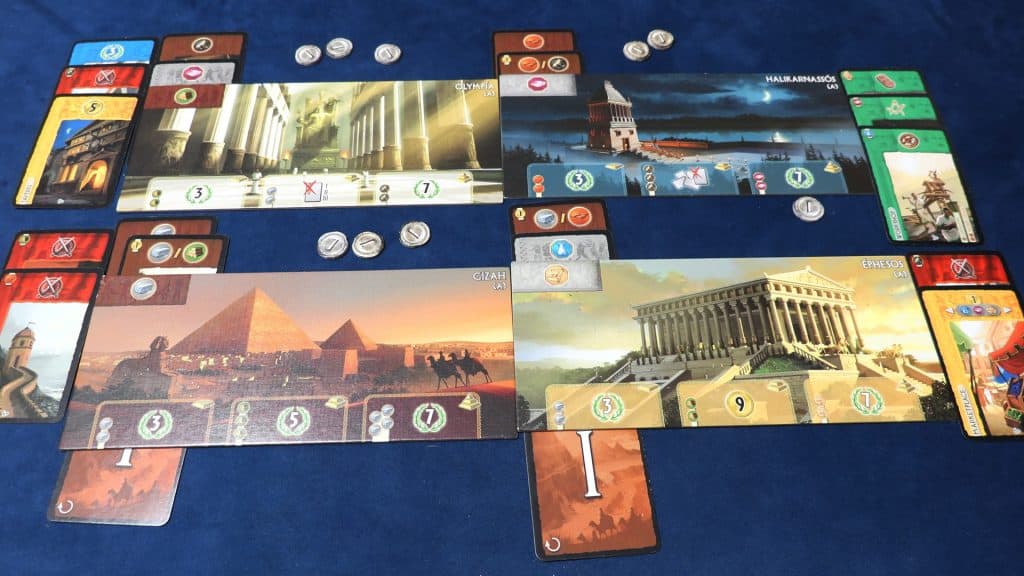Card drafting games are some of my favorite board games, offering everything I like about drafting Magic: The Gathering (MTG) without the expense of having to buy packs every time I want to do so. I find the best draft environments offer a wide variety of strategies and experiences that keep you coming back for more without being so complicated as to bog down the gameplay.

Apparently, I’m not the only one, as 7 Wonders is the gateway game for those wishing to teach or learn how to draft in a board game setting.
It’s not hard to see why, either. For those coming over from collectible card games like MTG, the structure of gameplay is very similar, with 3 ages representing your “packs”. The cards are big, easy to read, and simple in their design, making them feel more approachable for newcomers of all ages.
7 Wonders also won’t hog an entire board game gathering if you want to get a few different games in, as a typical game can easily be run from start to finish in under an hour. For those who really enjoy the gameplay, however, this means you can also easily fit several games into your afternoon or evening without issue.
If you can’t play in person, that’s no problem either! Board Game Arena has a great version of the base game available, and as long as 1 player of your group is a Premium member, you and up to 6 friends can play at your own virtual table as much as you like. Best of all, nobody has to be in charge of sorting cards or keeping score!
How to Set Up 7 Wonders
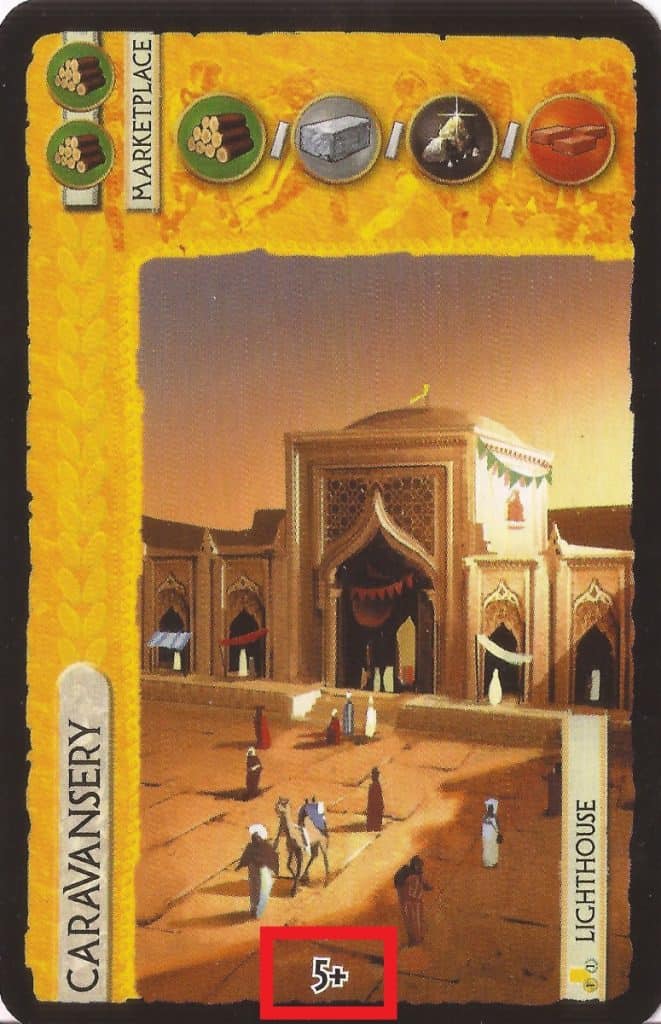
Note: I’ll only be discussing the base game from this point forward – adjust for expansions as needed.
First, you’ll need to make sure the cards for the 1st, 2nd, and 3rd Ages are separated from each other. Each Age has a distinct Roman numeral and color on the back (1st edition uses orange, blue, and purple, but 2nd edition uses bronze, silver, and gold), making sorting quite easy.
Next, you’ll need to go through each deck and remove all cards that have a number at the bottom that is greater than the number of players playing, as noted on the card off to the left (for 2nd edition, this number is on the bottom right of each card). Once done, return the removed cards to the box.
After that, go through the 3rd Age cards and separate out the 10 purple Guild cards. Shuffle them face down, randomly select a number of them equal to the player count plus 2, then return the rest to the box.
Finally, give each player 3 coins, then shuffle the Wonder cards face down and deal 1 to each player. This will determine their Wonder for the game. Wonders are double-sided, meaning you can choose to:
- Have all players play with the front side (recommended for newcomers, as the mechanics are simpler)
- Have all players play with the reverse side
- Have each player’s side be determined by which side is right side up on their dealt Wonder card
- Have each player choose which side they’d like to play
All of these are valid methods for determining which wonders everyone will be playing, so feel free to choose what works best for your playgroup.
How to Play 7 Wonders
7 Wonders is divided into 3 Ages. During each Age, players begin with a hand of 7 cards. Play then proceeds as follows:
- Each player selects 1 card from their hand and places it in front of them face down.
- Once everyone has selected their card, they perform an action with it. Your available actions are:
- Reveal and build the card you selected (as long as you have or can get the necessary resources from your neighbors, and as long as you have not already built an identical card).
- Build the next stage of your Wonder (as long as you have or can get the needed resources from your neighbors). Your selected card remains face down and is placed under your Wonder with the bottom part of the card back showing to indicate it is built.
- Sell the card by discarding it face down for 3 coins.
- Pass your remaining cards to the left (1st and 3rd Ages) or right (2nd Age).
- On everyone’s 6th card selection for the Age, they will pick one card, then discard the last card face down rather than passing it. No coins are gained by discarding this final card.
At the end of each Age, military conflicts are resolved with the neighbors on your immediate left and right. Each victory will give you 1 point in the 1st Age, 3 points in the 2nd Age, and 5 points in the 3rd Age, while each loss will always cost you 1 point.
All other scoring occurs at the end of the game. For further details and clarifications, you can refer to the original rules or 2020’s 2nd edition rules, depending on which edition of the game you play.
7 Wonders 1st Edition vs 2nd Edition
While there are differences between the 1st and 2nd edition versions of 7 Wonders, many of these changes are strictly cosmetic, meaning you don’t need to scramble to get rid of an older version. A representative of the publisher has also gone on record confirming this, ensuring veteran players with 1st edition copies can rest easy.
2nd edition does strive to clean up and do a little rebalancing compared to 1st edition, however. Many Wonders have been adjusted, cards in the Age decks have received updates, building chains have been updated, and the rulebook is MUCH easier to navigate.
For a comprehensive list of changes between 1st edition and 2nd edition, I’ve taken the liberty of compiling them here. Enough has changed between the games to make mixing game components a bad idea, but the rules and flow of play remain intact, meaning that most strategies will be similar between editions as well.
Since the Wonders have the largest number of changes between editions, we’ll be taking a look at both the 1st and 2nd edition boards when discussing strategy. Sides marked “A” and “B” come from 1st edition, while sides marked “Day” and “Night” come from 2nd edition.
7 Wonders Wonder Boards & Their Preferred Strategies
The Lighthouse of Alexandria
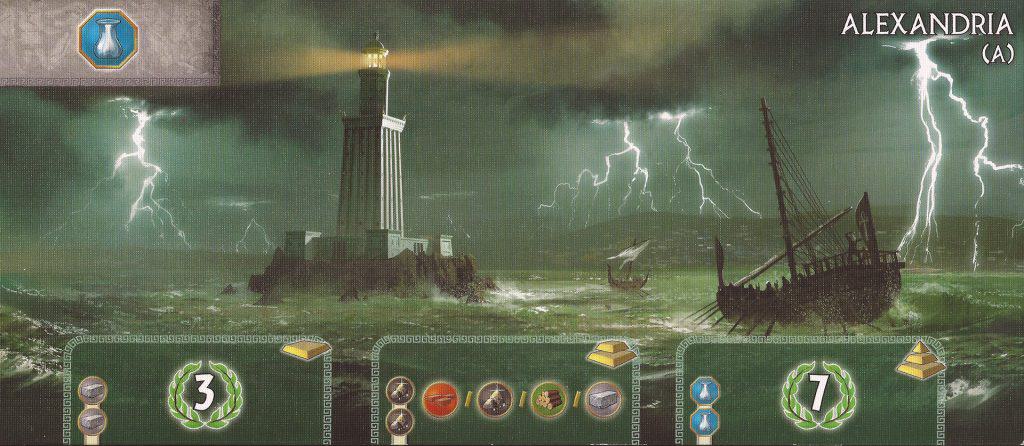
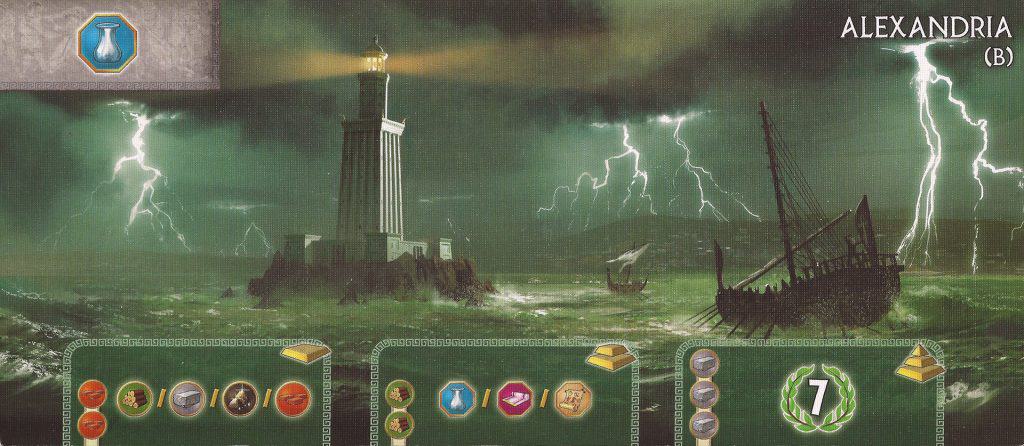
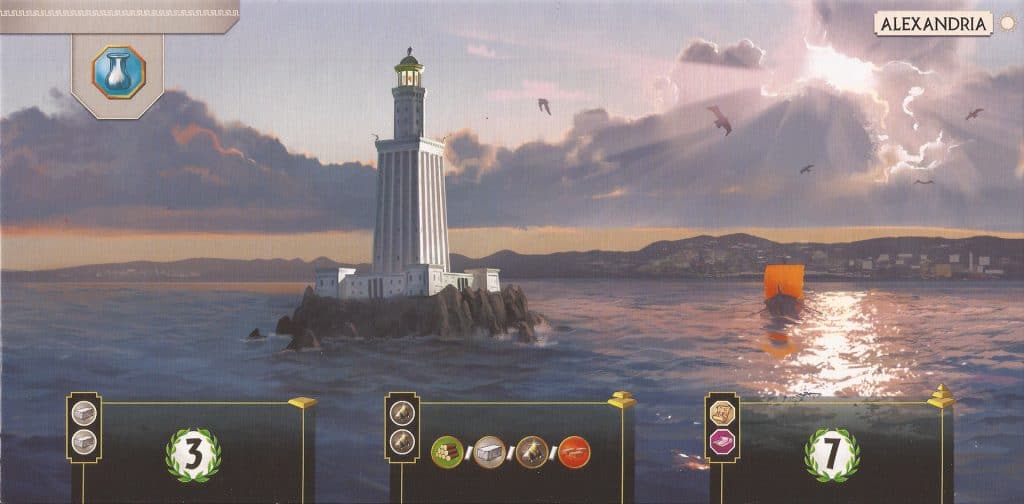
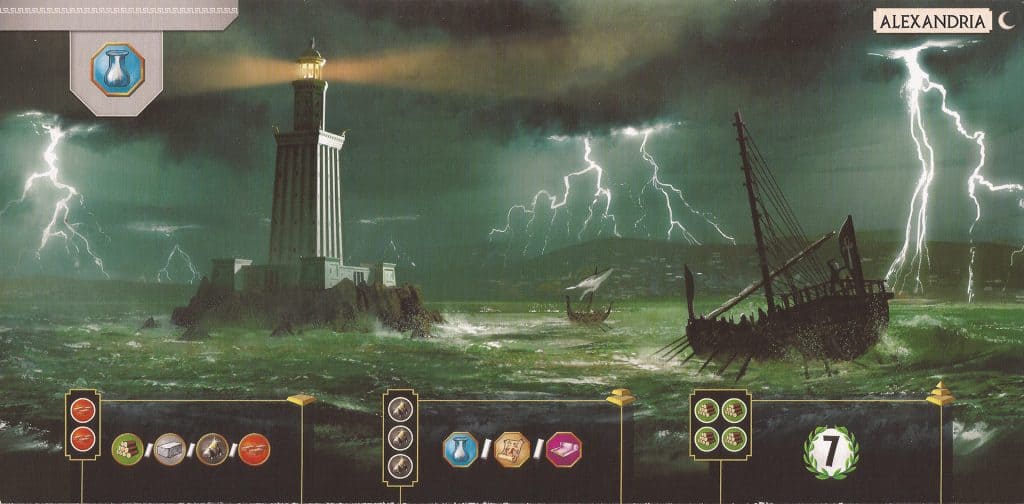
Strengths: Resources, Wonder building
Weakness: Steep resource requirements (2nd edition only)
Recommended side: B (1st edition), Night (2nd edition)
Alexandria’s never a bad Wonder to draw. In 1st edition, it’s incredibly powerful, allowing you to turn up to 2 cards into resources, which is super useful if you know you’re coming up short toward the end of the 2nd Age.
1st edition’s version of Alexandria also synergizes with itself on both sides, taking advantage of the glass it generates for the 3rd stage of its wonder on A side, and completion of the 1st stage of its wonder for the 3rd stage on B side. Resource requirements for all stages of both sides are also low, making it easy to quickly finish by early in the 2nd Age.
Savvy traders might even finish by the end of the 1st Age, which is incredibly fast for a completed Wonder, and thanks to the extra resources, you are well positioned to collect more powerful cards and score a boatload of points.
It is very obvious this was deemed too good for 2nd edition, as both the Day and Night sides are noticeably worse. Day side’s 3rd stage now requires a Loom and Papyrus to build, which while useful to have in the 3rd Age, is just a giant middle finger for someone trying to rush the construction of Alexandria.
Night maintains the synergies of B side from 1st edition, but both the 2nd and 3rd stages of the Wonder require an extra resource each. This matters quite a bit more than the changes to the needed raw materials themselves, as it slows down your ability to fully complete Alexandria by at least 2 turns.
For both editions, their boards’ reverse sides are always the better pick if you have a choice – trading away 3 points for an extra resource and faster access to it is well worth it.
The Hanging Gardens of Babylon
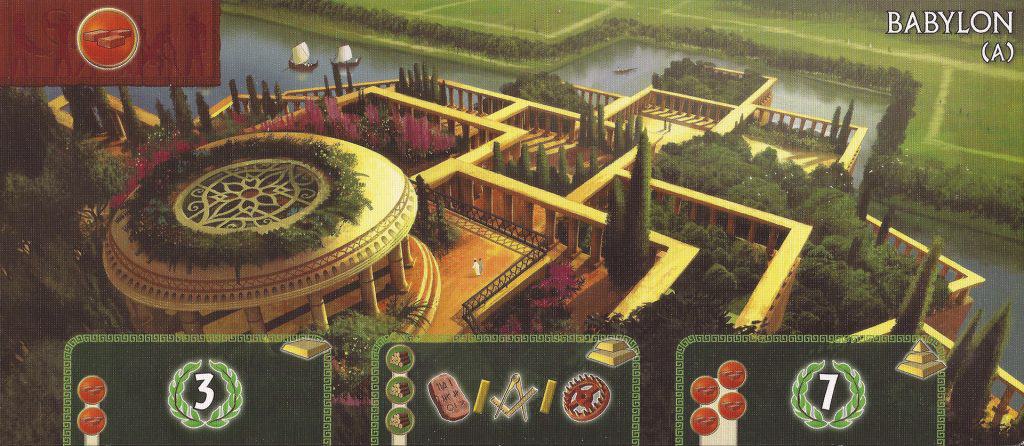
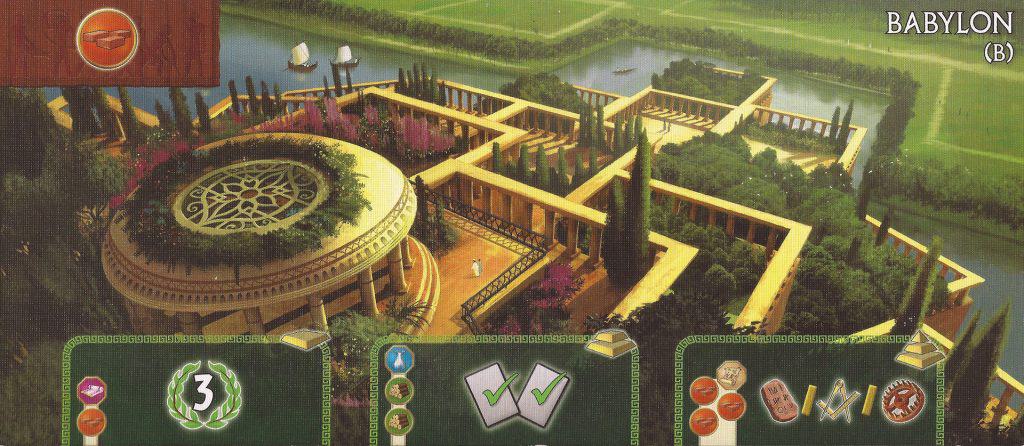
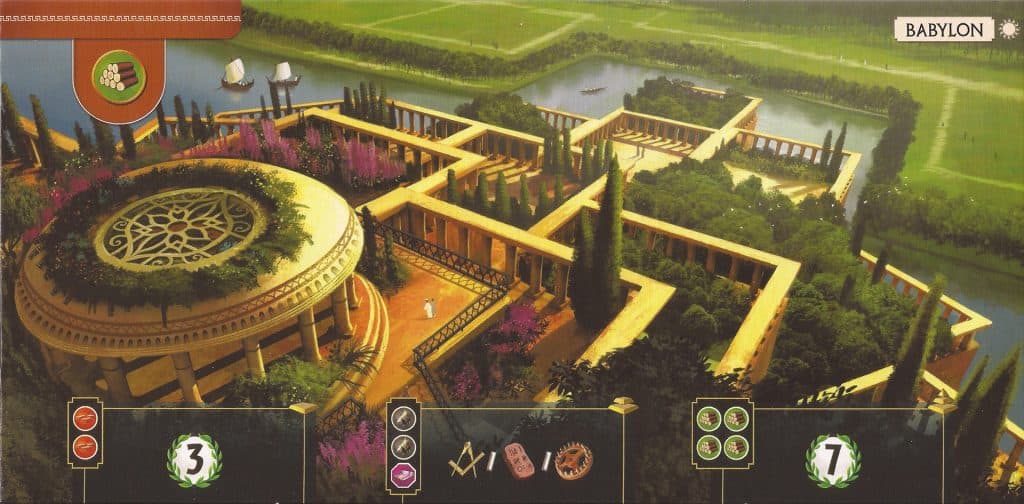

Strengths: Science, Extra cards
Weakness: Low guaranteed Wonder points (reverse sides only)
Recommended side: B (1st edition), Night (2nd edition)
Babylon presents one of only 2 ways in 7 Wonders to generate a science symbol outside of a science card (the other being the Scientific Guild in the Age 3 deck). This can represent at least 8 points if you use this to complete a single set, or more if you have a good run on science cards throughout the game.
That said, if your neighbors keep science cards out of your hands, you may only be able to score 1 point with this stage of Babylon, which is some of the worst possible card value you can get. This can make the A and Day sides very tempting for a less experienced player, and both are fine choices if you want some extra strategic flexibility.
This is a trick meant to trip up newbies. Don’t fall for it.
The B and Night sides are considerably more powerful in my opinion, as they give not only a science symbol, but also let you play the 6th and 7th cards of an age, meaning you can have up to 3 more cards than your opponents. That’s basically half an extra Age, all to yourself, and should net you more than the 10 points you’d get from finishing the A and Day sides.
Much like Alexandria, 1st edition Babylon has a lot of synergy between the clay it generates and the clay it needs to build its wonder, but I consider the fact that B side forces you to build a 3 point stage before you can build the all-important ability to take extra cards at the end of each Age a big drawback compared to 2nd edition.
2nd edition’s change from clay generation to wood strips away most of the synergy for building Babylon, but you only have to build 2 stages to complete Night side, and both can have significant impact if you’re playing science.
If you are forced away from the science game, however, the ability to just take extra cards and not have to worry about building more than 1 stage of your Wonder is also quite powerful. You can spend more time on a military, grab a trading post, and hoard extra point cards guilt-free, which will make you a powerful force in most games.
The Temple of Artemis in Ephesus
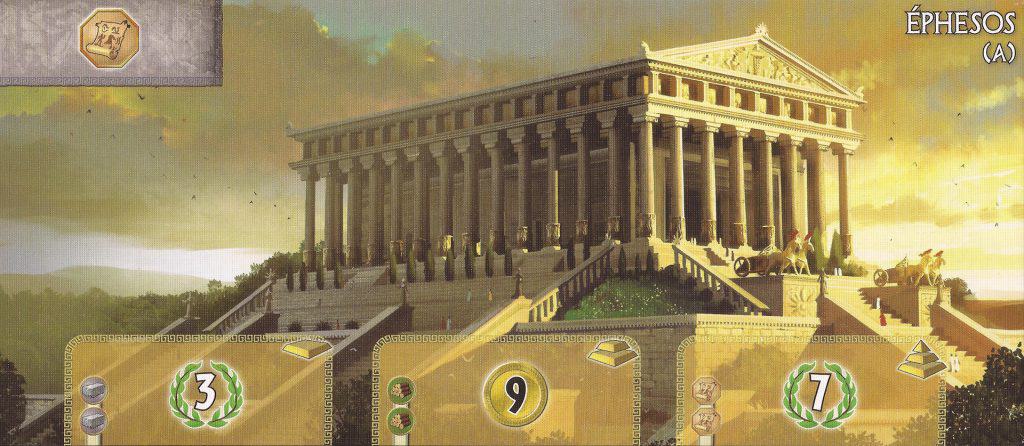
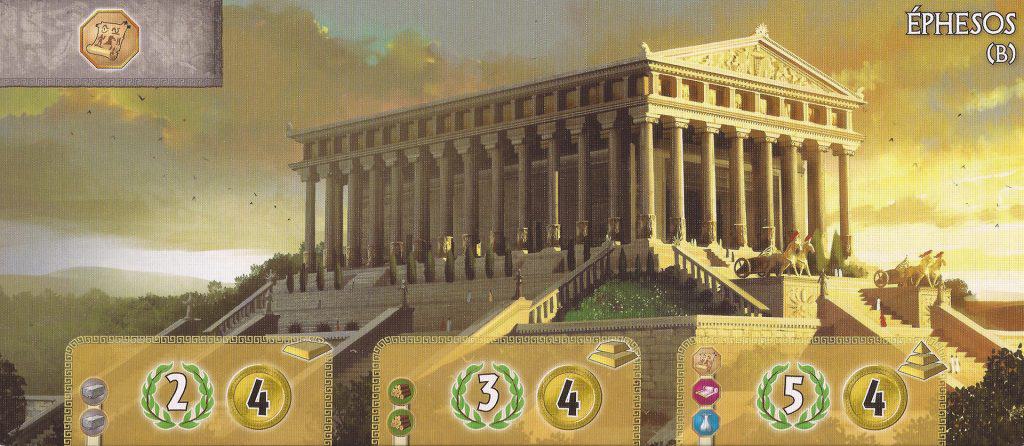
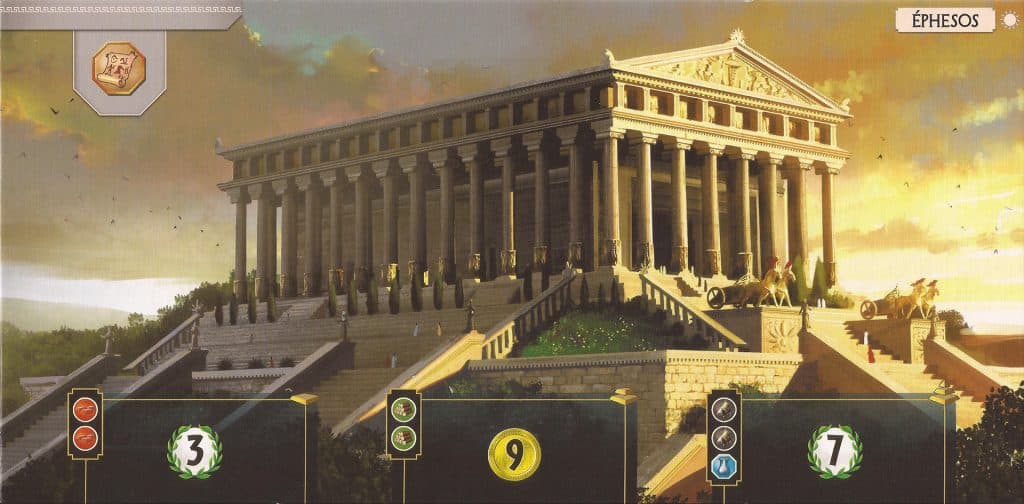
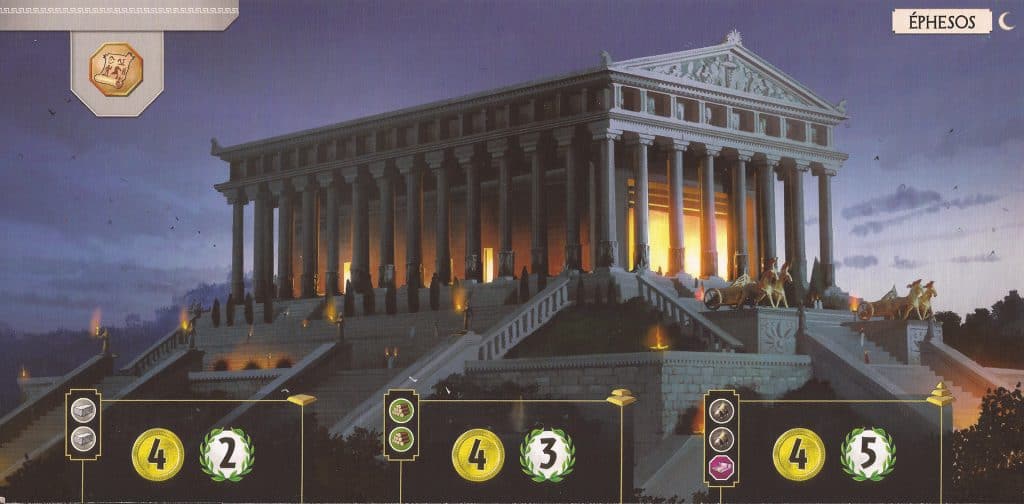
Strength: Treasury
Weakness: Low impact compared to other Wonders
Recommended side: Any
I don’t like Ephesus – I’d even go so far as to say it is the weakest Wonder. In 1st edition, you at least got a bit of a break building the last stage of Ephesus with the Papyrus you generate, and I will admit that the coins you generate can smooth over resource deficiencies throughout the course of a game via trade with your immediate neighbors.
2nd Edition strips the lone saving grace of Wonder synergy, however, and while I appreciate the reduced dependency on manufactured goods like glass and looms, it just wasn’t a fair trade for an already underpowered Wonder.
This isn’t strictly a fault with Ephesus, however – it’s a fault with how coins work in 7 Wonders. While trade is sometimes incredibly important in a game to access resources you don’t have on hand, it is easy to circumvent paying your neighbors fair value with a trading post or two while achieving that same benefit.
Add in the fact that coins exchange 3:1 for points at the end of a game, and having a stash of 20 coins is suddenly much less impressive. The reverse sides of both boards are technically stronger than the fronts, but an extra 3 coins really isn’t anything to brag about, especially since they’re spaced out across the Wonder stages rather than giving out a big payday like the front sides.
On the bright side, the Papyrus production will serve you well for science cards and many guild and point cards in the 3rd Age, so if you draw this short straw, you’ve got that going for you at least.
The Pyramids of Giza
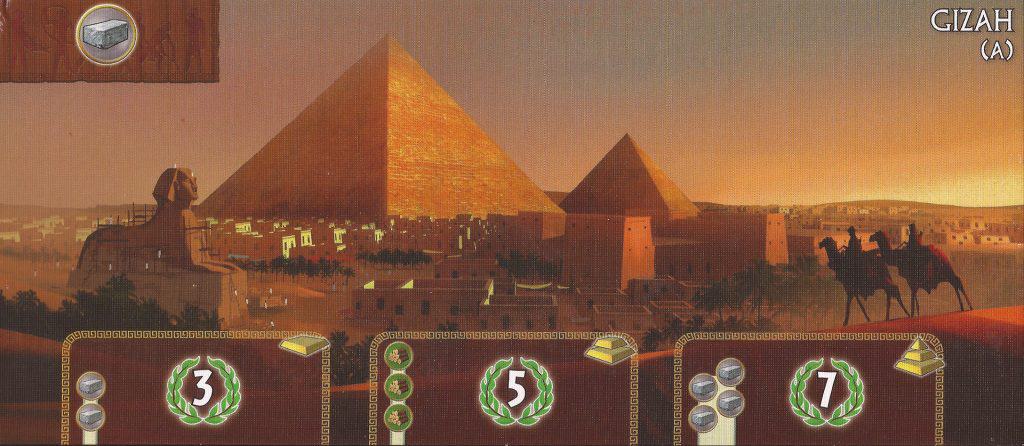
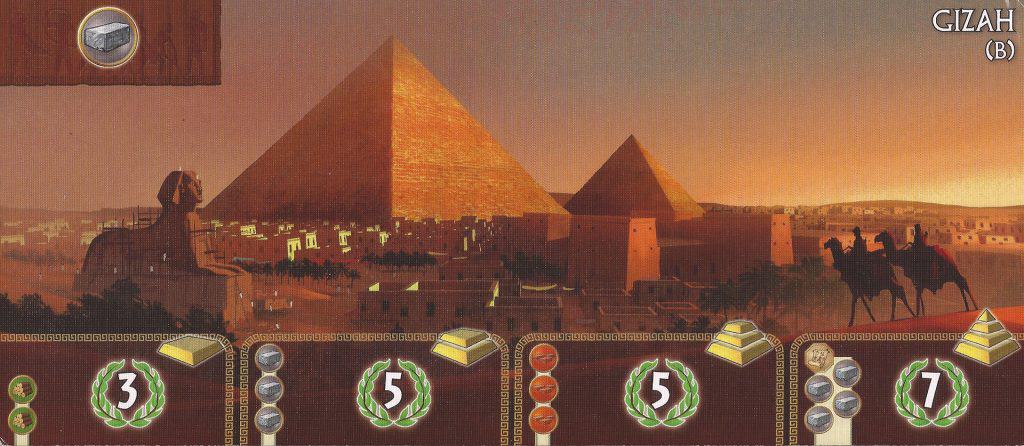
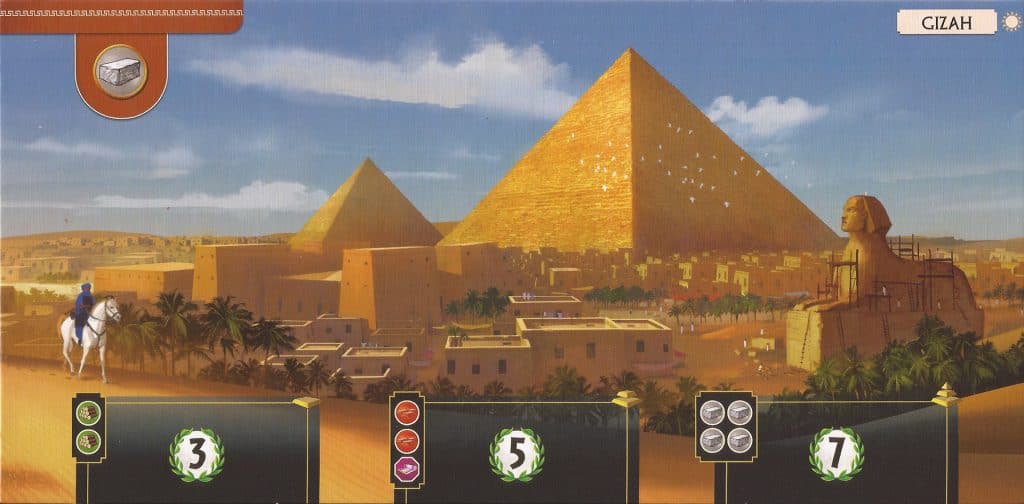
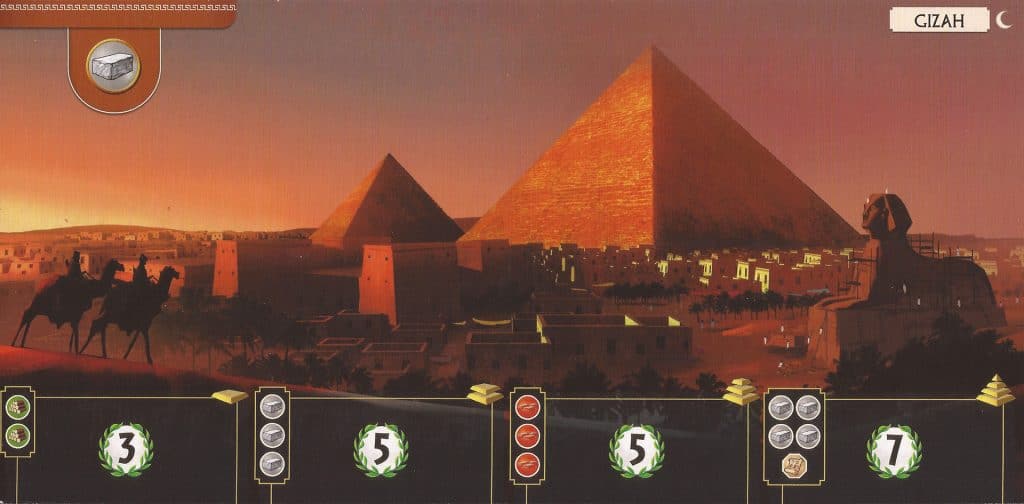
Strengths: Points, Wonder building
Weakness: Steep resource requirements
Recommended side: Any (1st edition), Night (2nd edition)
Giza is as straightforward as it gets. Build a stage of your Wonder, get points. You even have built-in synergy with the stone you generate for 1-2 stages of your Wonder, making an already clear strategy even easier.
The day side of 2nd edition is so much worse than 1st edition’s A side though. Synergy is stripped away and you need 2 entirely new resources to finish building Giza, one of which is a loom. I’ll admit A side was too easy to build, but the nerf bat hit Giza’s Day side a little too hard in my opinion.
Night side remains unchanged from B side between editions, and can net you a whopping 20 points. This 4 stage Wonder construction is also a feature unique to Giza and makes cards like the Arena and Builders Guild in the 3rd Age better for you than anyone else. Make sure to keep an eye out for them as cards start circling the table!
The Mausoleum of Halicarnassus

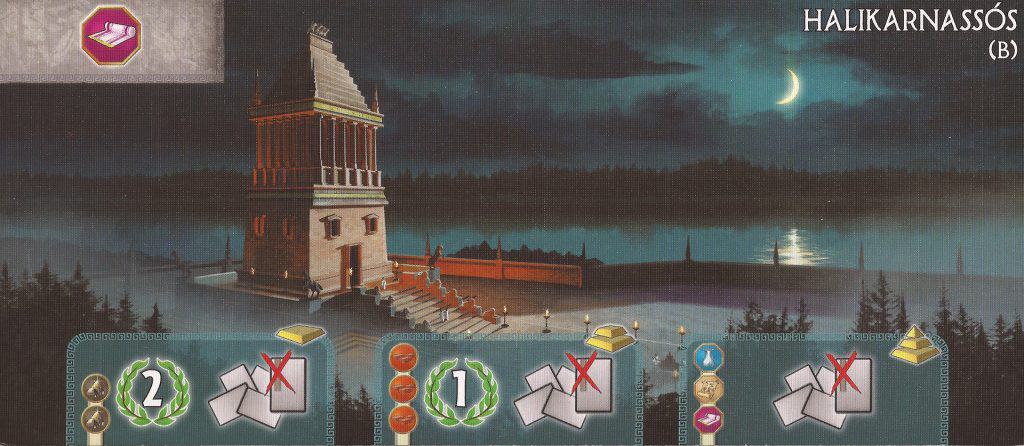
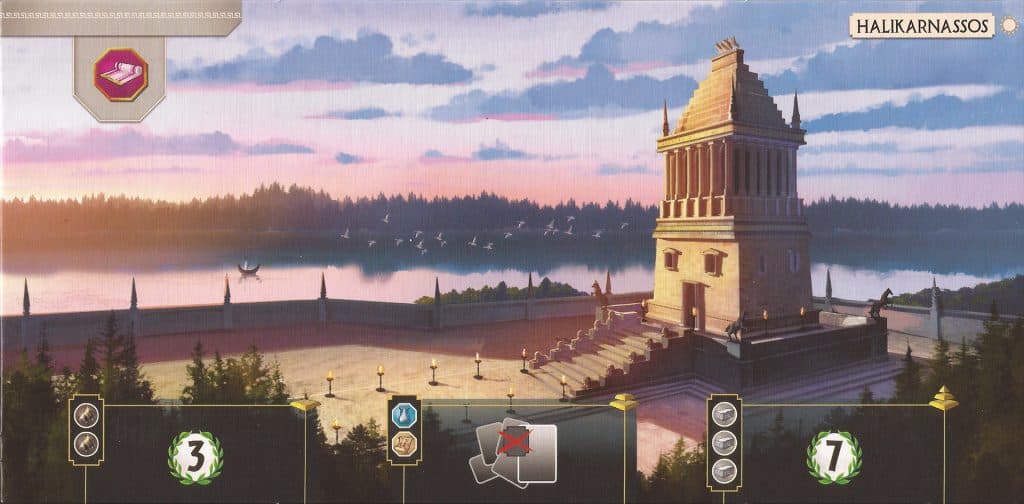

Strengths: Strategic flexibility, Extra cards
Weakness: Low guaranteed Wonder points (reverse sides only)
Recommended side: B (1st edition), Night (2nd edition)
Being a mausoleum, it really isn’t a surprise that Halicarnassus specializes in digging through the discard pile. On the bright side, this means that unlike most Wonders, you do not need to rush building it to completion. On the other hand, it can also make knowing when to build your wonder an extremely complicated affair.
If you’re playing on the front side of Halicarnassus, you should not build your Wonder’s 2nd stage any earlier than the 2nd Age, and even then, there are arguments to be made for waiting until someone sells a card for 3 coins or until the 3rd Age to have the widest selection of discarded cards.
The reverse side gives you 3 shots at the discard pile, so the 2nd Age is the earliest you’ll contemplating building any stage of your Wonder, and even then, you’re probably only building at that time to collect missing resources or to snag an extra Science card when there isn’t a better pick toward the end of the Age.
The end of Age 3 is another great time to build stages of this Wonder, as the really strong cards should be picked over by then. If for some reason they aren’t, that’s also good news for you, so not building your Wonder is hardly the end of the world.
Like many revisions for 2nd edition, Halicarnassus loses its construction synergy with the loom it produces, but this change in conjunction with the other construction adjustments doesn’t actually make it harder to build, which is appreciated.
The Statue of Zeus in Olympia
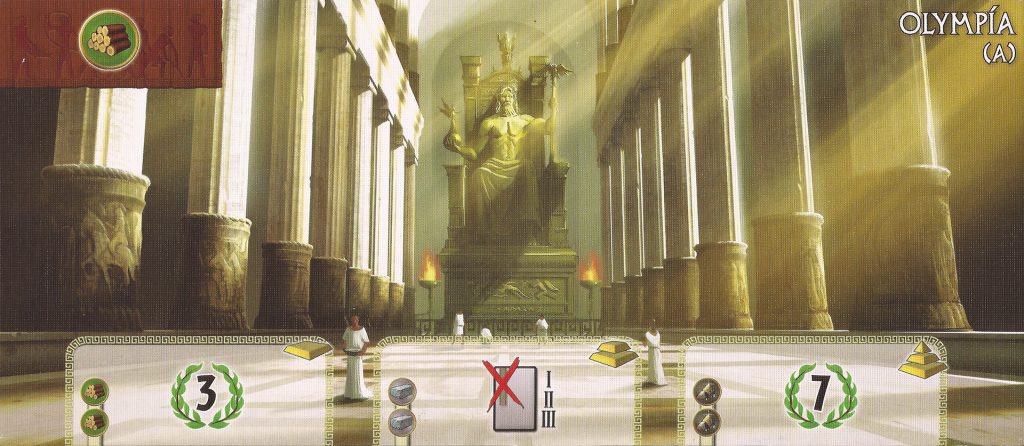
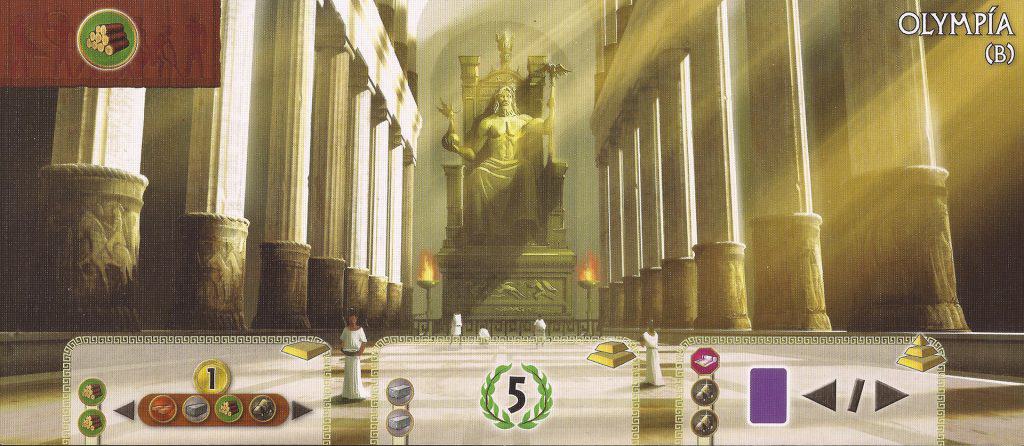
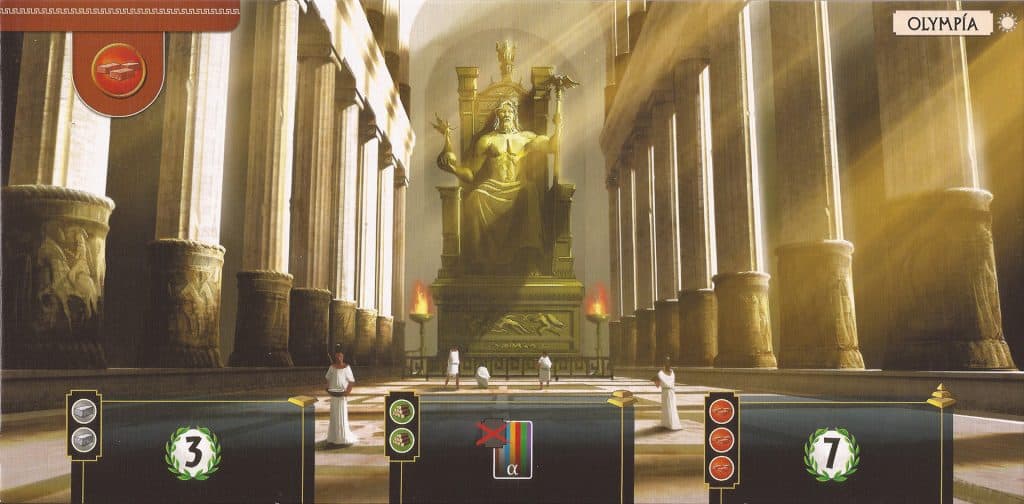
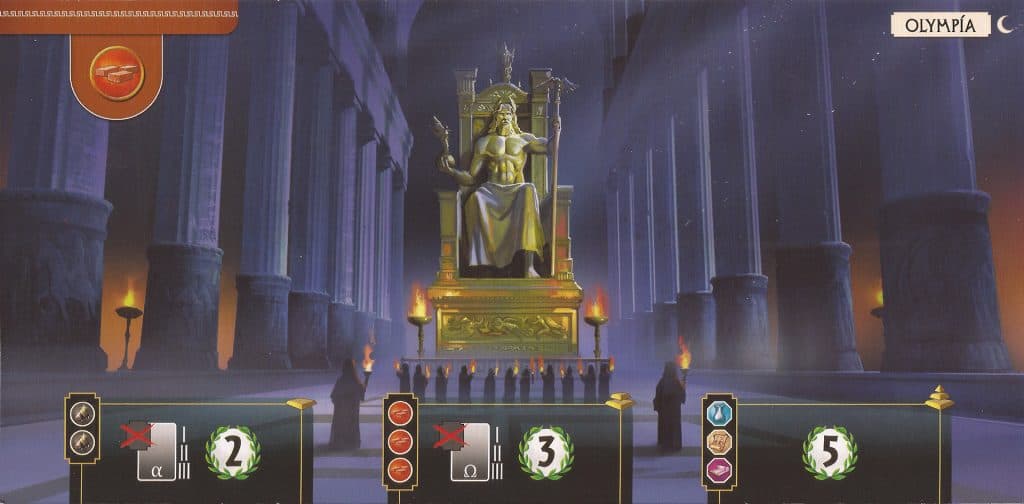
Strengths: Resource management, Strategic flexibility
Weakness: Unfocused or Restrictive Wonder benefits
Recommended side: B (1st edition), Day (2nd edition)
Olympia’s the odd duck among the 7 Wonders, behaving completely differently between 1st and 2nd editions. In 1st edition, your A side’s 2nd stage lets you build one card per age for free, ignoring all resource requirements. This can be huge in both the 2nd and 3rd Ages, as cards that require 3 of the same raw material or a bunch of manufactured goods become infinitely easier to build.
B side gives you access to a near immediate trade cost reduction with your neighbors, which suddenly makes coins very, very useful if your neighbors are picking up a lot of resource. This ability, which would normally take 2 1st Age cards to achieve, makes Olympia the only Wonder I’d recommend prioritizing a few extra coins early for.
It also means if you can make a neighbor dependent on you for a resource to get coins flowing in, you’ll effectively have 3 fully accessible pools of resources to draw from, letting you prioritize any cards you want.
Oh, and the ability to copy a neighboring guild at the end of the game is often quite strong too – rush to build that stage before the 3rd Age if you can so you can effectively trade a 1st or 2nd Age card for a stronger 3rd Age card.
2nd edition elected to lean into the cost reduction mechanics of Olympia instead of the trade or copy mechanics, and the Day side clearly does it better. That rainbow on the card signifies that you can build the first card of each color for free.
The insert in the box is incredibly misleading as to what this means, as it reads like you can do this in every Age. This is not the case per the 7 Wonders FAQ – this effect only applies to any color of card not already present in your city.
This is still extremely powerful, as you could be building 3-5 cards of your choice without having to worry about resource costs. I personally recommend holding back as many of these until Age 3 as possible, as some of the resource requirements for those cards are ridiculous, and are often the reason players pick up too many resources in the 1st and 2nd Ages.
Night side is nice enough to still give you 10 points (an improvement from the 5 of 1st edition), but its free builds are limited to the first and last cards of an age, respectively. Naturally, the former is far more useful, as you’ll have the widest pool of cards, and while the latter isn’t bad per se, it definitely is underwhelming by comparison.
You also can’t use these free builds to construct your Wonder, so you’d better hope you get something semi-decent to work with as your last pick of each Age.
The Colossus of Rhodes
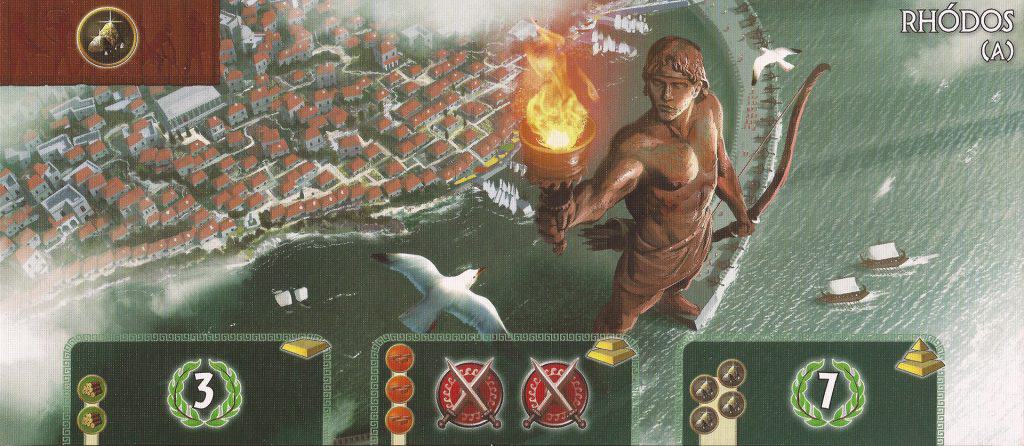
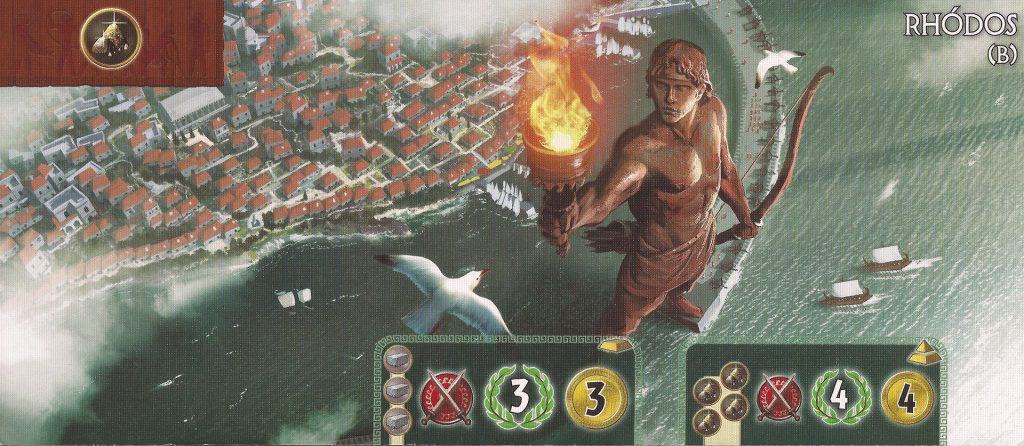

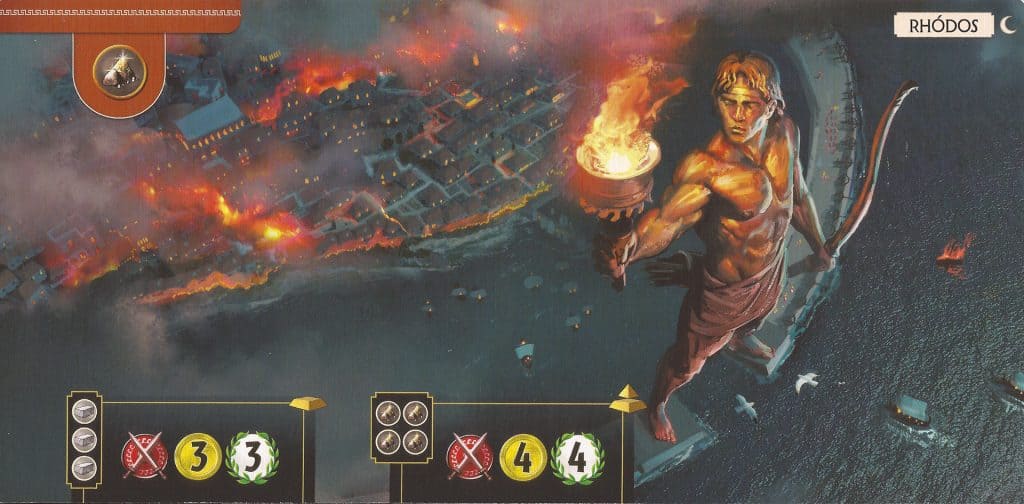
Strengths: Military, Treasury (reverse sides only)
Weaknesses: Below average Wonder points (reverse side only), steep resource requirements
Recommended side: A (1st edition), Day (2nd edition)
Rhodes was so bad in 1st edition, the designers didn’t even bother to hit it with the nerf bat for 2nd edition.
Sadly, they didn’t improve it either.
Fighting Ephesus for the bottom spot among Wonders, Rhodes has a little more to offer, keeping it in 6th place. The front side’s 2 military shields are the real prize here, as it is very easy for opponents to miss that when calculating how much military might they need to hold you at bay, letting you sneak in victories you wouldn’t have gotten otherwise.
Best of all, you’ll can make the most of this in either of the first 2 Ages, so you can take the time you need to collect the large amount of required clay to build it.
The reverse side only has 2 stages, but while the coins are nice, I feel splitting up the shields between the 2 stages is a huge drawback. There’s a flow to how military battles work that I’ll be touching on shortly, and B side just doesn’t mesh with it outside the 1st Age.
This is especially problematic because the reverse sides have extremely steep resource requirements, making it a challenge to get the 1st stage of your wonder built in Age 1, where it is poised to do you the most good.
7 Wonders Strategies and How to Score Them
Resources (Raw Materials and Manufactured Goods)
Resources are a necessary evil in 7 Wonders. While they won’t score you a single point themselves, failure to get enough of them in the 1st and 2nd Ages will stop you from building other cards that will. This is because they act like mana in MTG, serving as resources for cards you wish to build that refresh after every draft pick.


In larger games of 6-7 players, prioritizing these cards is even more important, as it is both possible and sometimes easy to lock sections of the table out of specific resources.
This is especially devastating with raw materials, as they’re used for building almost everything. If you and your immediate neighbors all have no direct access to a material like ore or stone by the end of the 2nd Age, your odds of winning drop dramatically.
The resource cards you’ll need most will vary depending on your Wonder, the strategies you elect to pursue during the game, and which resources your neighbors build. For example, science cards will often require you to have access to at least 1 of each manufactured good to consistently pick them up, whereas military cards will rely heavily on raw materials.
Despite their incredible importance for the construction of cards, it is generally best to try and acquire exactly as many resources as you need, and not a single card more. While having extras can be good for forcing opponents to pay to trade with you, there are enough trading posts that reduce or negate trading costs to render this strategy unreliable.
Even if you successfully force your neighbors to pay you a ton of coins in trade costs, the exchange rate for points from coins is 3:1 at the end of the game, so significant wealth isn’t going to be a major contributor to your score barring a rare case.
Military
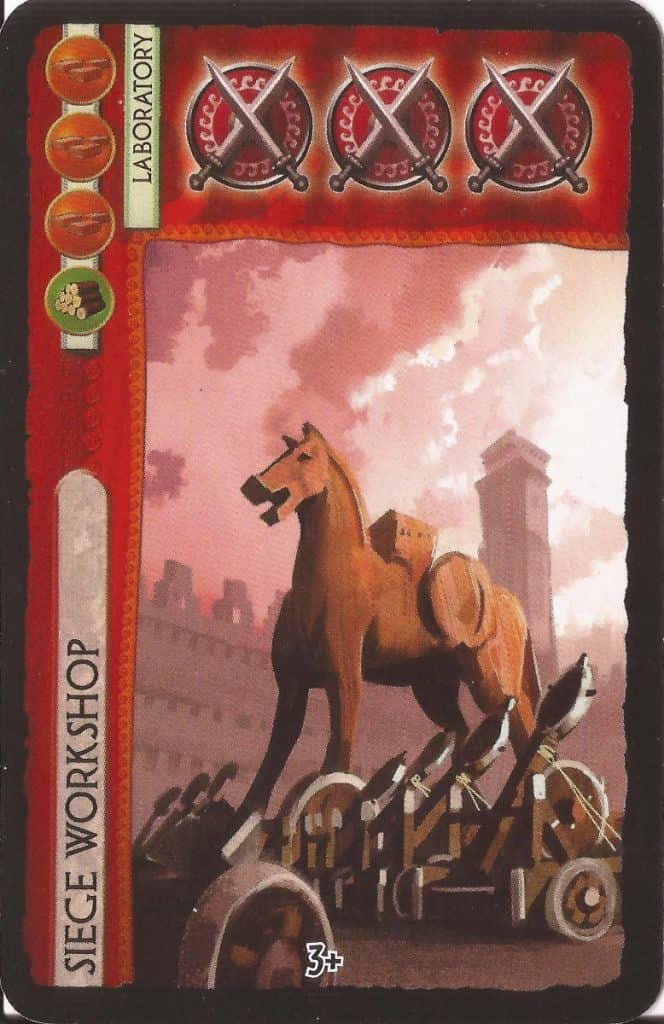
Military is another strategy that rewards taking exactly what you need and not another card more. Unlike every other strategy in the game, however, military strength scores at the end of of every Age, not simply at the end of the game.
The military strategy is also unique in that it is the only one that can actually attack an opponent’s point total. If someone loses every military fight to both of their neighbors during the game, they’ll lose 6 total points, which can wreak havoc with their placement in the standings. Even losing as few as 2 or 3 can mean the difference between 1st and 2nd place.
A successful military setup is all about pacing. There are a couple different routes you can take in this vein. If you choose to take the lead, your goal is to stay at least 1 shield ahead of your neighbors in the 1st Age, effectively meaning you need 1 more military card than them.
From there, each time a neighbor takes a military card in the 2nd Age (2 shields each), you only need to respond by taking one later in the round, and making sure you aren’t overtaken during the 6th and final pick. Repeat in the 3rd Age with the 3 shield cards, regardless of whether you have to take any military cards in the 2nd Age, as the math works out to be effectively the same.
The other method involves following your opponent. If your opponent is exactly 1 shield ahead of you in the 1st Age, a single 2-shield military card will put you in the lead and force them to follow your pace. Winning in Age 1 only nets you a single point per neighbor, so going all-in on military at the expense of other cards during that stage of the game is a poor proposition in most cases.

Babylon’s reverse side and both sides of Halicarnassus are well suited to this second approach as they can potentially sucker punch an opponent trying to maintain a military lead with their extra cards, and put them on the back foot in Age 3. Rhodes is also dangerous as they can strengthen their military simply by building their Wonder.
A flawless military campaign against your neighbors will net you 18 total points (1 from each opponent in the 1st Age, 3 each in the 2nd, and 5 each in the 3rd).
On its own, this makes military weaker than multiple other game plans, but it is a stellar supplemental game plan if you don’t have to invest many cards in it. If you do have to take a lot of red cards in a 2nd edition game, however, you have access to the new Ludus card in the 3rd Age, which can help you make up a lot of ground.
Coin Total (Treasury)

The treasury and your resources, as was alluded to in the resource section, go hand in hand with one another. Resources on their own are worth nothing at the end of the game, but if one or both of your neighbors are forced to pay you a lot of coins to use them, it opens up your own trade options and can net you enough coins to make a few points by game’s end.
Coins can also be acquired or saved a few other ways:
- Commercial structures can either give you a cash infusion or reduce the cost of trading with your neighbors.
- Boards like the reverse side of Rhodes or either side of Ephesus can generate them by building your Wonder.
- Discarding a card can net you 3 coins in a pinch, but should only be used in an emergency or to torpedo a very dangerous card.
You only get 1 point for every 3 coins you have at the end of the game, but this is the least efficient means to get points in 7 Wonders. so you should never prioritize this route. The only possible exception is if you can lock a neighbor out of a resource they need, and even then, it should really be a raw material like clay or wood for you to consider this plan.
Building Your Wonder
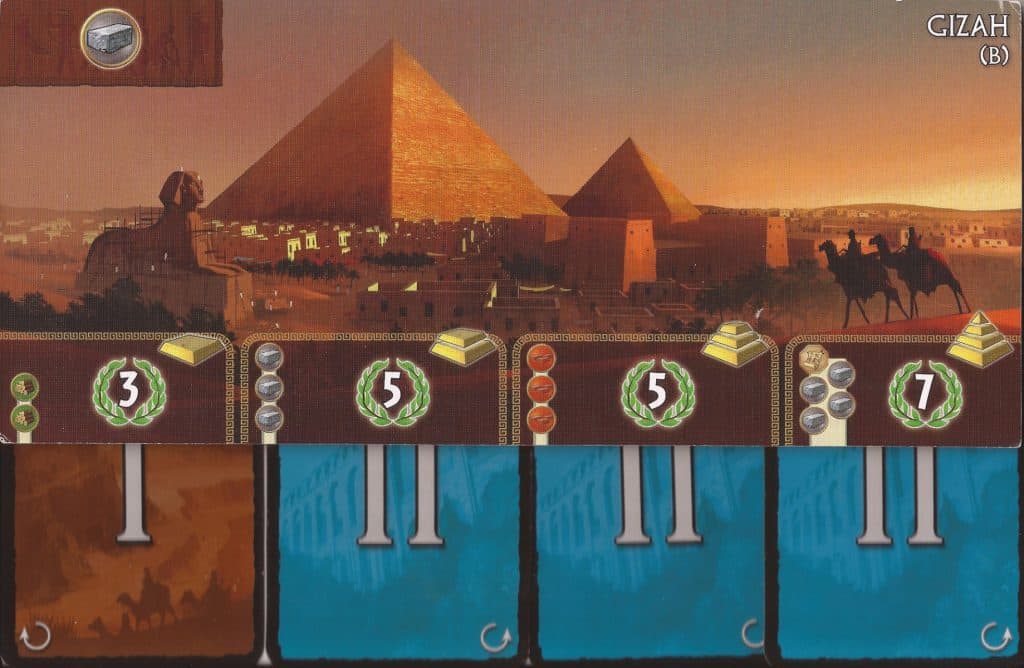
The point value of Wonders is 10 points for anyone playing on the front side (with the exception of Giza, which scores 15), but the reverse side can vary dramatically. Giza is the top point generator at 20, but there’s much more nuance involved in determining any reverse side’s point merits.
To build a stage of your Wonder, you must sacrifice a card you could build instead. This means that it will be easiest to build your Wonder up after collecting resources from the 1st and 2nd Age, but far more profitable to push for building most Wonders as soon as you can in those ages instead.
Halicarnassus is often the exception to this rule of thumb, as it rewards your patience by letting you root through the discard pile for any card of your choice.
If you aren’t able to build your Wonder super quickly, timing your upgrades so you can simultaneously hate draft a card your neighbor wants is also a powerful move, especially since sacrificing a card to your Wonder also keeps it out of the discard pile Halicarnassus is greedily eyeing.
Failing that, building up your Wonder with a card from a weak hand is never a bad play, so one way or another, you’ll have a good chance to do so before the end of the game.
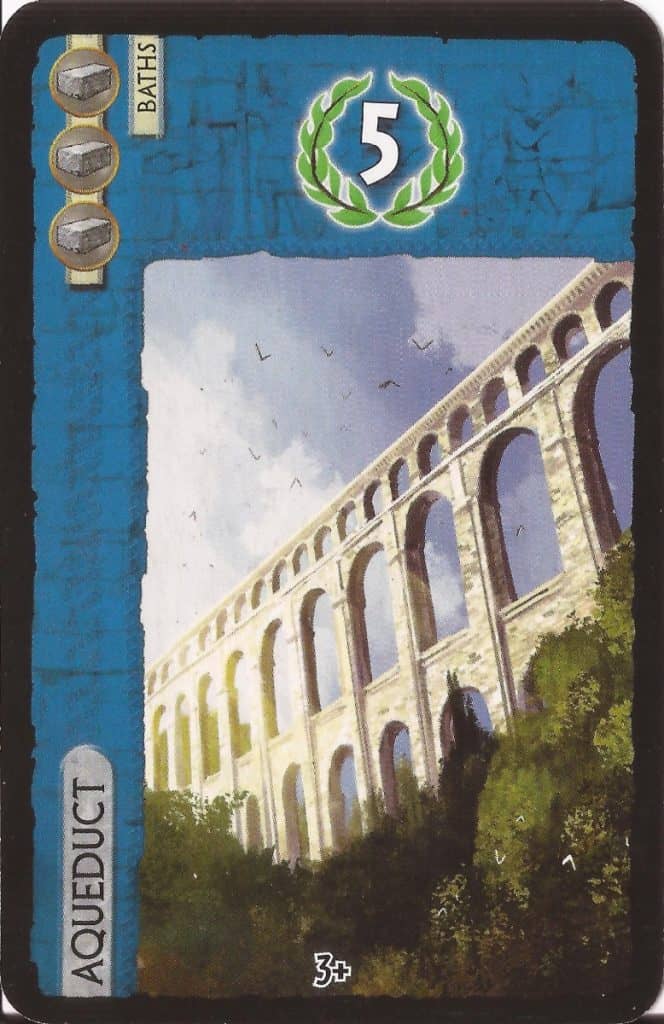
Point Cards (Civilian Structures)
I perpetually underestimate these cards, and have become much more aggressive about picking them up over the years. The value these bring in is often no joke, and is only rivaled by a strong science or guild game. 20-30 points easy if you make a concerted effort to pick them up across all Ages, and sometimes 21 points even if you only pick them up in Age 3.
Beyond that, there really isn’t much to say – these do exactly what they say they will, and do it well to boot.
Science
Science cards work out 1 of 2 ways – uselessly weak or backbreakingly overpowered. This is due to how science scores with its 3 unique symbols:
- For each science card you have containing the same symbol, square the total.
- So if you have 1 gear, it’s worth 1 point, 2 gears are 4 points, 3 gears are 9 points, etc.
- For each set of 3 unique symbols you have, score 7 points
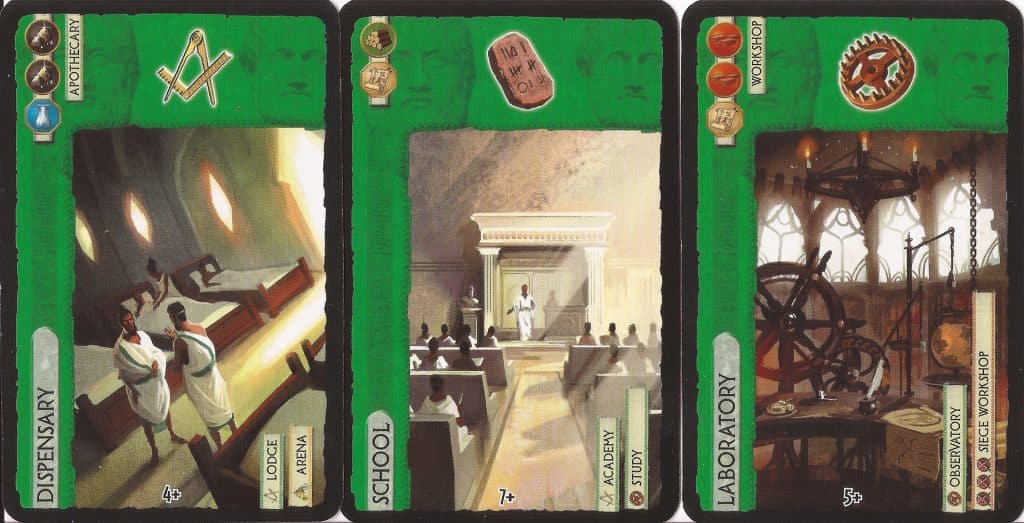
If your neighbors are blind and/or careless, this means you can score up to a whopping 76 points by building all 4 of each symbol. The Scientific Guild and Babylon’s Wonder can further increase your total another 20 points beyond this maximum if you somehow collect everything during your stay in Magical Christmas Land, where all your wildest dreams come true.
While this is extremely unlikely to happen, a good science run can still net upwards of 50 points, so paying attention to who is accumulating it is imperative, and hate drafting it is often a necessary evil the table will have to endure.
On the other end of the spectrum, forcing science when others are going for it is usually a poor draft strategy, as you could end up with as few as 8 points with 4 cards (2 pairs of symbols). This example of a weak science game represents incredibly poor point economy, turning around once you reach roughly 2 full sets of symbols, or roughly 5 points per card.
If your mediocre scientific accumulation stopped the birth of a supervillain like Shane, however, that’s probably worth the loss. Check out our Unqualified Experts episode on 7 Wonders for context.
Commercial Structures

Commercial structures often feel like the glue that binds the flow of a game together. They’re not a series of cards I would ever recommend going all-in on, but a few here and there can have an impact far beyond your expectations.
In early ages, trading posts are usually good pickups, as they offer you a flexible resource from a neighbor’s stash at a partial cost or a completely free resource of your choice. Conversely, cards that give you simply a fixed amount of coins can be useful, but are almost always weaker since their impact occurs only once.
Commercial structures in the 3rd age are easily the best, as you can score immediate coins and endgame points by capitalizing on your otherwise weak or worthless cards like resources, other commercial structures, and even your military cards in the 2nd edition!
Not the strongest cards at face value by a long shot, but between accumulated value and cash infusions, they don’t have to be to be welcome and/or useful pickups.
Guilds
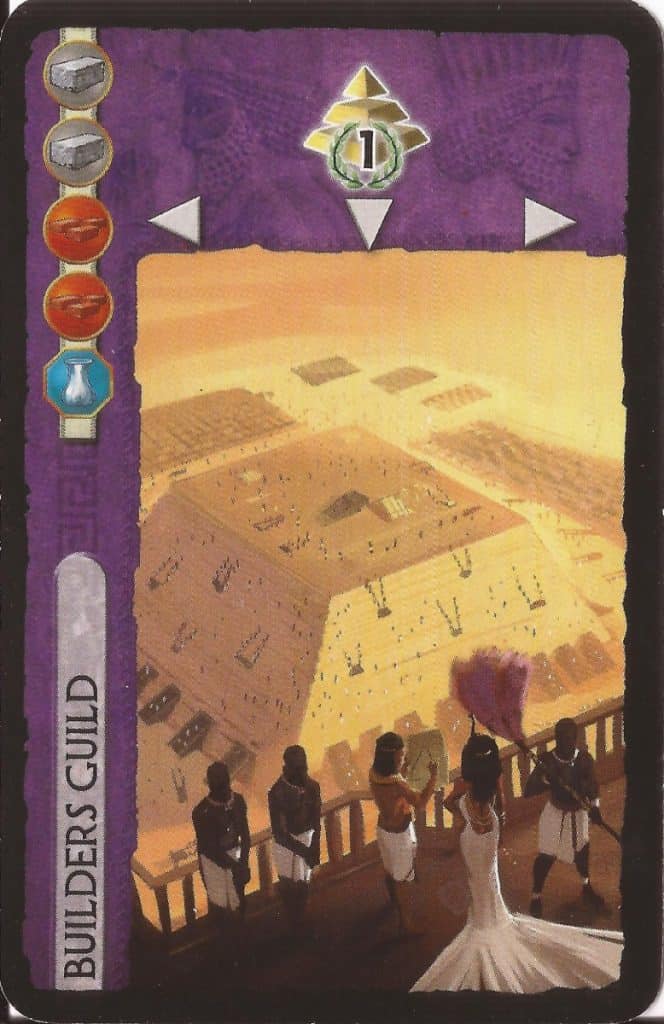
Only available in the 3rd Age, guild cards represent huge payoffs for specific strategies – if you’re lucky enough to see the one(s) you need.
There are 3 things working against you when dealing with guild cards:
- Of the 10 guilds, only a number equal to the number of players + 2 are added to the Age 3 deck.
- Guilds usually require 2-3 of the same resource to build
- Your opponents are very likely to hate draft a guild that will obviously benefit you
Fortunately, many of the guilds have a universal appeal, so if you don’t get the exact one(s) you want, picking up one that rewards what your neighbors are doing or other cards you have in abundance usually works out well too.
On the whole, a useful guild should net you a minimum of 5-6 points (on par with the weakest point cards of the 3rd Age), and can often exceed that baseline handily under the correct conditions.
Just do the math and check what your neighbors are up to before making a decision, and you’ll avoid most obvious blunders the guilds can present. Now that I think about it, that’s good advice for playing 7 Wonders in general.
Additional 7 Wonders Game Tips
Pay Attention to Your Neighbors
The players on your left and right are going to be either passing cards to you or receiving cards from you during various Ages of 7 Wonders, so keeping an eye on what they’re doing serves two purposes.
First, you can see which strategies they’re actively pursuing, which will clue you in on cards that will be hotly contested. This should also put you on alert to look for cards that will help their strategy, so if one that will give them 10-15 points comes along, you will recognize the importance of keeping it out of their hands.
Second, the cards your neighbors aren’t taking will give you insight as to which strategies are open. If your neighbors have no military cards partway through Age 1, this is your cue to take one and start putting them on the defensive. Seeing a lot of science floating around? Be the supervillain you want to see in the world.
Make Sure You Draft Enough Resources and Trading Posts
I’ve touched on the importance of Resource cards already, but if you have the choice of drafting too many or not enough, too many is always better. Failure to draft enough resources will put you in a position where you need to frequently replenish your treasury through commercial structures or selling cards so you can buy resources from your neighbors.
Assuming they even have the ones you need. If not, you’re simply out of luck.
If you do find yourself in need of coins, try to pick them up by building a card rather than selling one for 3. You will usually get far more money to work with as a result, and sometimes you’ll even pick up points for the end of the game too!
Don’t Forget About Building Chains

Many buildings in the 2nd and 3rd Ages of 7 Wonders can be built for free if you built a specific building from an earlier Age. This can take significant strain off the resources you need in the mid or late game, and often opens up several plays you might not realize are open to you.
2nd edition has an excellent guide for these (shown below). For 1st edition (shown on the Forum card), the lower right section of a card will show the next building(s) in a progression, and the upper left section next to the material cost will show you whether a specific building can be substituted.
1st edition building chains are available on Page 11 of the rulebook, or you can refer to this infographic I made from that page for easy reference.
Unlike 1st edition’s cards, 2nd edition instead relies on symbols in the upper right of a card and next to the building cost to clue you in on whether your building is a prerequisite for a future building or has a prerequisite for one you might have already built (as seen in the List of Chains below).
At least these symbols match up between parts of a building chain on the cards (so the upper right corner of the well and the upper left corner of the Statue both have a hammer), which is appreciated. Despite the quality of these symbols and the chart, I still feel that removing the specific card names from the cards was an error, as it would have added an extra level of verification without creating significant clutter.
Is 7 Wonders a Good Game?
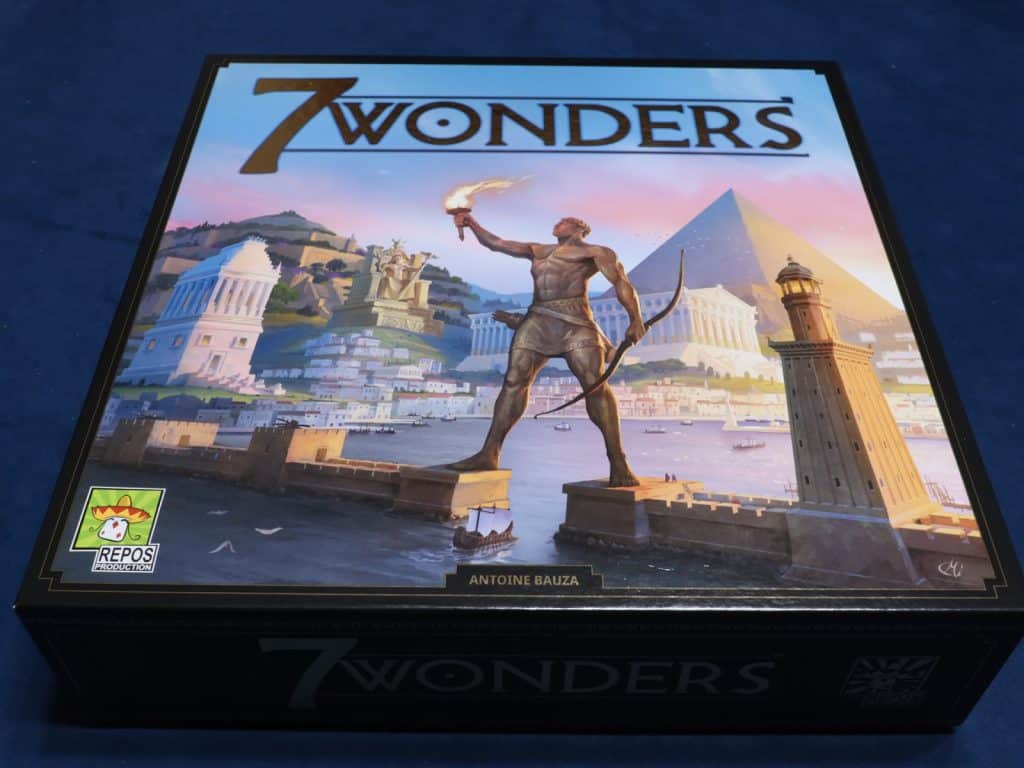
7 Wonders is an excellent game for new and experienced board game enthusiasts. New players will appreciate the straightforward nature of most mechanics and the streamlined version of the 2nd edition rules.
Experienced players will enjoy the challenge of attempting to read draft signals from their neighbors and the replay value of trying different Wonders and strategies. There are also multiple expansions available that can change the gameplay further, ensuring each game’s experience stays fresh.
My favorite aspect of 7 Wonders, however, is its ability to accommodate groups of 3-7 players and provide very different experiences depending on your player count. It’s relatively rare for a board game to allow more than 6 players to play at a time, so it’s a perfect game for small circles of friends, family gatherings, or big board game sessions at your friendly local game store.
Board Game Articles You’ll Also Enjoy
- How to Win at Pandemic
- Settlers of Catan Settlement Placement Guide
- Mansions of Madness vs Betrayal at House on the Hill
- The Red Dragon Inn’s Best Characters
- Bunny Kingdom Strategy Guide
Braden is a founder of Assorted Meeples and has been a gamer & writer with a vivid imagination all his life. Don’t believe us? Check out his excitement when meeting Goosebumps author R.L. Stine as a kid! An avid Magic: The Gathering spellslinger for over 15 years, you can always convince him to shuffle up for a game (or three!) of Commander.

